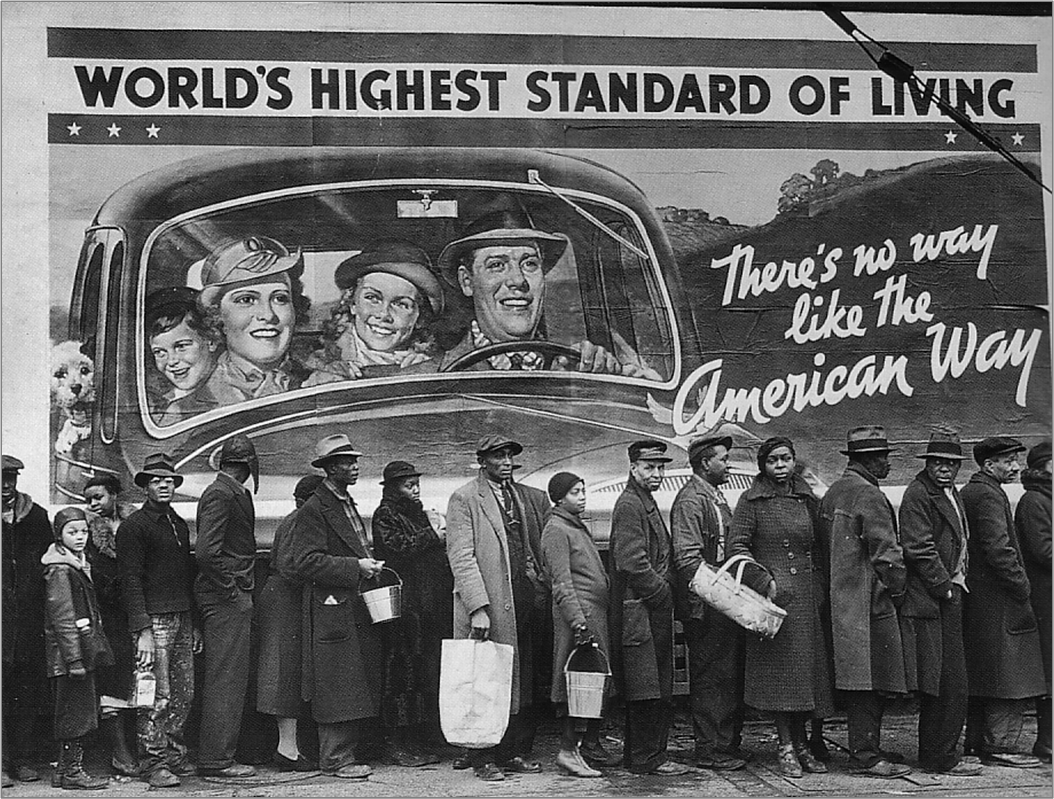More languages
More actions
No edit summary Tag: Visual edit |
m (Updated category name) |
||
| (4 intermediate revisions by 2 users not shown) | |||
| Line 1: | Line 1: | ||
The '''Great Depression''' was a severe economic depression between 1929 and 1939 that affected all market-based [[Capitalism|capitalist]] economies. It was predicted as early as February 1928 by the Central Committee of the [[Communist Party of the United States of America|CPUSA]].<ref name=":0">{{Citation|author=[[William Z. Foster]]|year=1952|title=History of the Communist Party of the United States|chapter=The Communist Party and the Great Economic Crisis (1929-1933)|title-url=http://williamzfoster.blogspot.com/|chapter-url=http://williamzfoster.blogspot.com/2013/01/chapter-twenty-communist-party-and.html}}</ref> The [[Union of Soviet Socialist Republics (1922–1991)|USSR]] | [[File:Great Depression breadline.png|thumb|Breadline in front of a [[Capitalism|capitalist]] propaganda poster in Louisville, [[Commonwealth of Kentucky|Kentucky]], [[United States of America|USA]].]] | ||
The '''Great Depression''' was a severe economic depression between 1929 and 1939 that affected all market-based [[Capitalism|capitalist]] economies. It was predicted as early as February 1928 by the Central Committee of the [[Communist Party of the United States of America|CPUSA]].<ref name=":0">{{Citation|author=[[William Z. Foster]]|year=1952|title=History of the Communist Party of the United States|chapter=The Communist Party and the Great Economic Crisis (1929-1933)|title-url=http://williamzfoster.blogspot.com/|chapter-url=http://williamzfoster.blogspot.com/2013/01/chapter-twenty-communist-party-and.html}}</ref> The [[Union of Soviet Socialist Republics (1922–1991)|USSR]] experienced immense economic gains during this time, since rational planning took the place of market mechanisms<ref>{{Citation|author=R. Dutt|year=2009|title=Fascism and Social Revolution|publisher=Wildside Press}}</ref> and [[New Deal]] [[Democratic Party (United States)|Democratic]] types depended heavily on Soviet grain imports. | |||
Between 1929 to 1933, industrial production in the Soviet Union increased by 67% and wages doubled while unemployment dropped to 0%.<ref name=":0" /> | Between 1929 to 1933, industrial production in the Soviet Union increased by 67% and wages doubled while unemployment dropped to 0%.<ref name=":0" /> | ||
The | The failure of capitalist countries and the success of [[Socialist state|socialist ones]] during the Great Depression led to a major rise in [[Socialism|socialist]] movements across the world, although it also contributed to the rise of [[fascism]] in [[German Reich (1918–1933)|Weimar Germany]].<ref>[https://www.britannica.com/event/Great-Depression/Political-movements-and-social-change Political movements and social change]</ref> | ||
== References == | == References == | ||
[[Category:Stubs]] | [[Category:Stubs]] | ||
<references /> | <references /> | ||
[[Category:Economic | [[Category:Economic crises]] | ||
Latest revision as of 01:38, 28 December 2022

The Great Depression was a severe economic depression between 1929 and 1939 that affected all market-based capitalist economies. It was predicted as early as February 1928 by the Central Committee of the CPUSA.[1] The USSR experienced immense economic gains during this time, since rational planning took the place of market mechanisms[2] and New Deal Democratic types depended heavily on Soviet grain imports.
Between 1929 to 1933, industrial production in the Soviet Union increased by 67% and wages doubled while unemployment dropped to 0%.[1]
The failure of capitalist countries and the success of socialist ones during the Great Depression led to a major rise in socialist movements across the world, although it also contributed to the rise of fascism in Weimar Germany.[3]
References[edit | edit source]
- ↑ 1.0 1.1 William Z. Foster (1952). History of the Communist Party of the United States: 'The Communist Party and the Great Economic Crisis (1929-1933)'.
- ↑ R. Dutt (2009). Fascism and Social Revolution. Wildside Press.
- ↑ Political movements and social change
